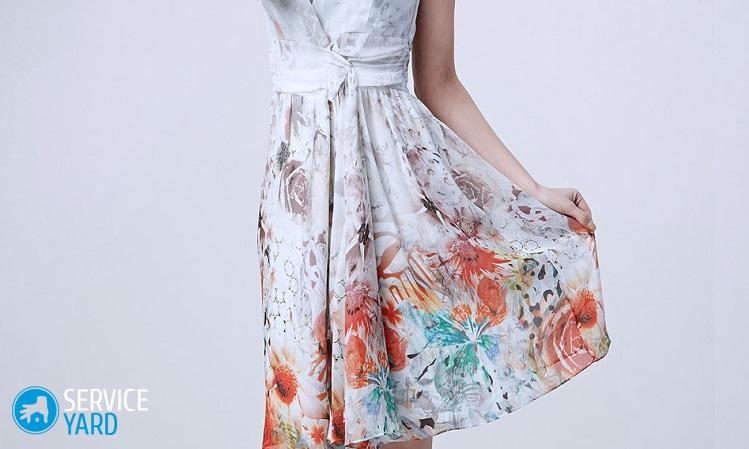How to sew a dress from silk?

People began to sew clothes from silk almost six thousand years ago. We learned how to make this soft and delicate fabric in the Neolithic era in China. Then, the technology of manufacturing material from silkworm fibers was mastered in other countries of Asia, and the production of an artificial analogue began in the last century. How to sew a dress from silk? This is not as difficult as it might seem at first glance, but this material has some specific qualities. Now we will discuss this.
to contents ↑Material properties
To sew a silk dress with your own hands, you need some experience in sewing craft. However, the lack of skill can sometimes be compensated by imagination and design abilities. But before you sit down to work, it is very useful to find out what exactly you have to deal with.
Silk is very beautiful, but it has other advantages:
- softness;
- ability to drape superbly;
- variety of colors.
Some properties of this material can create difficulties when working:
- he glides;
- the slices crumble rather strongly;
- A poor or improperly selected needle may leave puffs.
Two words about the style
It follows from the above that a beginning seamstress needs to think carefully about the style:
- the simpler the model, the better;
- there should not be too many details - it is better to refuse from coquets, valves, patch pockets;
- it is possible to leave the edges - it is better to do it.
If we talk about the best styles for the beginning dressmaker, the list will be something like this:
- Greek dress;
- tunic;
- kimono;
- sundress with narrow straps;
- dress with a narrow bodice and a flared skirt.
to contents ↑Important! In principle, clothes of any style and any style can be sewn from silk - it is enough to choose the right color and take into account that the material can have different densities.
Where to get the pattern?
A silk dress with your own hands can be sewn without any patterns at all. In this way, both a tunic and a dress with an open shoulder, and Greek, and a sundress are sewn. But for a model with a narrow bodice and a flared skirt, you need a pattern of the upper part. To build one yourself is a rather long and demanding task, so it’s better to order it in the studio or transfer it from the magazine.
If this is not possible, take an old, but suitable blouse in size, open it, remove all the threads and transfer to the cardboard a shelf, half of the back and one sleeve. Do not forget that you need to translate and tuck. Now you have a framework that can be modeled:
- carry tucks;
- replace tucks with reliefs;
- invent different styles of sleeves;
- adjust the width of the bodice;
- change the shape of the neck.
Greek dress
How to sew a dress of silk with your own hands, if you are not very confident in using the machine? You can’t imagine anything better than a Greek dress in such a situation.
Important! Such a similar one can be made not only of silk, but also of fine knitwear - in short, of fabric that drapes very well.
Calculation and preparation of materials, tools
The calculation of the material in this case is extremely simple:
- Measure the length of the product from the cervical vertebra to the bottom and multiply by 2.
- Add another 10 cm for hem processing and for possible errors.
For this model, in addition to fabric and cars, you will need:
- threads in the color of the fabric (silk or fine synthetics, but not cotton);
- threads for basting (thin cotton can be used);
- ruler;
- tape measure;
- square (preferably tailor's);
- chalk or soap.
Important! It draws chalk better on slippery fabrics, so it will be more convenient for them to cut.
Cut
The only thing you need to carve is a neck. Everything else is done directly on the figure, so it is better to do this work with an assistant:
- Fold a section 140-150 cm wide in half, aligning the edges, face inward.
- Since the fabric is slippery, chop it along the fold and along the edges with tailor pins (you can sweep it).
- Find the middle of the fold and put a point.
- At this point, draw a perpendicular to the depth of the cut.
- Set aside 10 cm from both sides.
- Connect these two points to the end of the perpendicular.
Important! The cutout can be the same front and back - in this case, just cut the drawn triangle without spreading the fabric. If you want it to be only in front, and the back remains solid - draw a line along the fold between the marks and cut the triangle out of only one layer of fabric, without touching the second.
Assembly
It consists of several stages:
- folds (only on the shoulders or shoulders and chest line);
- sewing side seams;
- neck and bottom processing.
Important! Since silk is crumbling, it is better to immediately process the bottom and neck with an overlock. But you can do this and then, as well as arrange the neck, otherwise - trimmed trim, for example. If you chipped or swept a section along the edges before cutting the neck - do not pull out the basting until it is more convenient for you to lay folds with it. In this case, the workpiece itself is better to turn on the front side.
Operating procedure:
- Set aside along the shoulder seam (that is, along the fold of the fabric) from the edge of 10 cm and make a mark (you can stick a pin).
- Set aside 5 cm from the mark and put this new mark on the previous one, pin the crease with a pin or sweep it.
- Do the same on the other hand, the folds should “look” towards the shoulder.
- In the same way, lay a few more folds - the step can be arbitrary, but it is important that the folds are symmetrical.
- Sew the workpiece over the shoulder seams.
- Turn the dress to the wrong side.
- Determine the width of the armhole - its lower point should be below the armpit, at least 5 cm, but you can also more.
- Sew side seams. Since you left the edges, you do not need to overcast the allowances.
- Folds can be sewn along three lines - the shoulder seams, at the chest and waist. If you have not processed the bottom, you can do it now by bending the cut by 0.5 and 1 cm to the wrong side.
to contents ↑Important! The side seams of this dress can not be sewn at all, the fabric is draped perfectly, so it will be enough to grab the dress with a belt.
Tunic
A tunic dress is also sewn from a whole cut, only folds should not be laid at all. Calculation of fabric and cutting are no different from those used in the Greek dress model. But you still need a strip of fabric for the drawstring. It does not have to be silk - you can take cotton or even a finished satin or crepe ribbon 3-5 cm wide.
Operating procedure:
- Fold the fabric with the wrong side facing out, aligning the edges, mark the outline and cut a cutout.
- Designate a place for the drawstring - it should go exactly under the chest (it is better to draw a line from two sides).
- On the front part, find the middle of the line, put a point with chalk, set aside 3-5 cm from each side.
- Make holes in the place of the new marks, mark them (if the silk is thick, you can insert the eyelets).
- Flatten the fabric.
- Cut out the drawstring itself, that is, cut a piece of tape whose length is twice the width of the fabric, minus 5-6 cm, cut it in half.
- Process the ribbon sections so that they do not crumble - overcast, hem or burn, depending on the material.
- Take the drawstring exactly along the line, leaving 2-3 cm to the edges.
- Sweep, stitch the side seams so as not to catch the edges of the tape.
- Work the hem and neck overlock or hem.
- Insert the drawstring into the drawstring, bring its ends to the front side.
to contents ↑Important! The drawstring does not have to pass under the chest, it can also be on the waist.
Sundress with narrow straps
This model, unlike others, is sewn along the transverse thread. The edges will be on the top and bottom, so you just have to stitch the back seam and sew the straps.
The calculation of the amount of fabric is simple:
- measure the circumference of the hips (the widest part of the body);
- multiply the result by 2;
- add 10 cm to the allowances and to the straps.
Important! In addition to the fabric, you will need another linen gum. In fact, such a sarafan can be without straps at all, if the chest is large enough.
Cutting and assembly:
- To begin, cut from a piece of 8 cm into the straps. It is better to cut them along the oblique - it's just strips 6 cm wide. Their length is equal to the distance from the clavicle to the scapula - it can be adjusted.
- Fold the strip in half, aligning the long slices.
- Iron the bend.
- Bend allowances inward, also iron.
- Sew the workpiece around the perimeter.
- In the same way, make a second strap.
- Overcast open sections.
The assembly of the sundress will be like this:
- On one of the edges, draw a drawstring, for which fold the parts with their faces to each other, align the long side of the drawstring with the top edge of the sundress.
- Unscrew the drawstring on the wrong side, iron it.
- Bend the bottom edge of the drawstring by 0.5 cm, stitch it - or, if it is a tape, then you can not bend it.
- Sew the back seam.
- Insert the rubber band.
- Mark the places for the straps, sew them.
Dress with a narrow bodice and a wide skirt
In this evening dress, only a skirt is made of silk. For the top fit:
- one-piece swimsuit with an open back;
- T-shirt frompolyester.
Important! Swimsuit or T-shirt can be in tone or contrasting. An interesting option is a black top and a colored skirt.
Cut
The calculation of the fabric depends on the type of skirt. For the sun, you need to take 4 lengths, for the half-sun - 2. You need two measurements:
- waist circumference
- length of the product.
Important! To determine the radius of the notch, you need to divide the waist circumference by 6.28.
The sun is like this:
- Fold the fabric in half and chop along the edges.
- Find the middle of the fold line and put a point or make a stitch - this will be the center of the notch, that is, the center of the workpiece too.
- Draw a semicircle from the center - you have already calculated its radius.
- From the same point, draw another semicircle, adding the length of the product to the radius of the notch.
- Make an allowance on the bottom, if you want to hem it, cut the workpiece.
Assembly
Handle the bottom of the skirt - overcast with hem or hem:
- At the leotard, cut off the upper part so that it does not reach the waist by the width of the elastic tape, and process the cut.
- Sew and stitch the top of the product to the elastic tape - do not forget that it must be slightly stretched.
- Measure what you have done.
- Take the notch of the skirt to the tape - of course, all seams should be on the wrong side.
- Measure and correct - although, most likely, nothing will need to be fixed.
- Stitch up the skirt.
to contents ↑Important! Such a model can be sewn from gas, guipure, tulle and other soft and well drapable materials.
Stock footage
In this article, we have offered you several options for models so that you can sew an interesting dress from silk without any difficulties. Try these methods, and then you can already model the original things yourself, based on your experience.
- How to choose a vacuum cleaner taking into account the characteristics of the house and coatings?
- What to look for when choosing a water delivery
- How to quickly create comfort at home - tips for housewives
- How to choose the perfect TV - useful tips
- What to look for when choosing blinds
- What should be running shoes?
- What useful things can you buy in a hardware store
- Iphone 11 pro max review
- Than iPhone is better than Android smartphones





